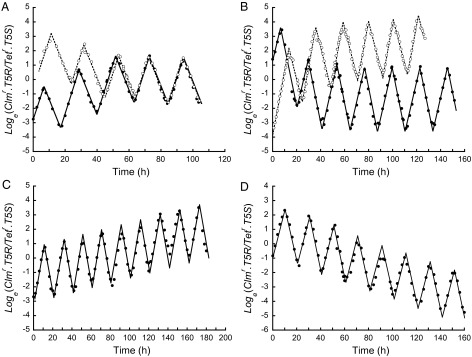Fig. 1.

The outcome of competition with alternating directional selection depends on the mechanism of population regulation. (A and B) Transferring cultures to fresh medium at a fixed population density leads to coexistence. (A) Two mixed cultures (open circles and filled circles), initiated at different clone frequencies, converge rapidly onto the same stable oscillation (alternating 0.12 μg/mL chloramphenicol and 0.55 μg/mL tetracycline). On reaching a density of 2.4 × 108 cells per milliliter, cultures were immediately diluted 1/100 into fresh medium containing the alternate antibiotic. (B) Changing the concentrations of the antibiotics changes the selection intensities and shifts the stable oscillation up (open circles, chloramphenicol now 0.22 μg/mL) and down (filled circles, tetracycline now 0.65 μg/mL). (C and D) Transferring cultures to fresh medium every 10 h regardless of population density leads to competitive exclusion. (C) Antibiotic concentrations identical to A. (D) Antibiotic concentrations identical to B (filled circles). The selection coefficients per hour (slopes) depend only on antibiotic concentrations and remain invariant regardless of clone frequencies, culture densities, and mechanisms of population regulation.
